What does Ixora look like and how to grow a flower?

Ixora is an exotic plant that is suitable for growing at home and is appreciated by flower growers. It is worth considering in more detail the features of the flower, the conditions of planting, care and reproduction.
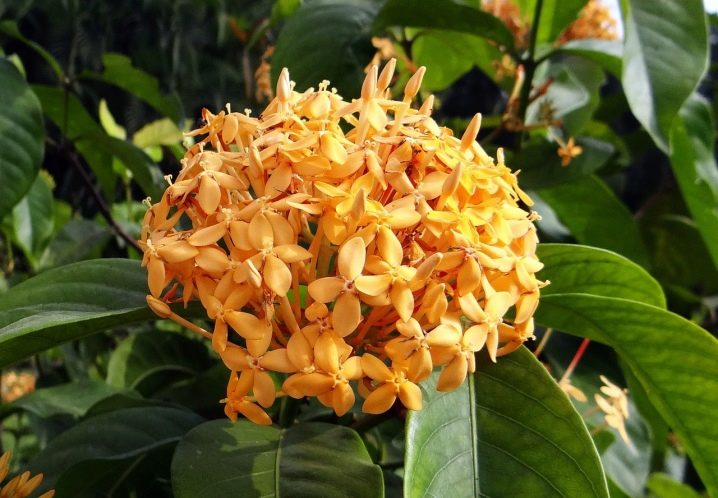
general description
Ixora is an evergreen shrub that grows primarily in tropical climates. Typical plant characteristics.
-
Escapes - up to 3-5 meters long. When grown at home, the length of the shoots is reduced to a meter. The surface is reddish or brown.
-
Leaves... Located on the shoots opposite each other. They have a glossy and leathery surface, the average length is 7.5-15 cm, but in some varieties the maximum length of the plates reaches 30 cm. The shape is obovate, elliptical or lanceolate, the shade is bronze.
-
Flowers... Small in size, gather as it grows in dense umbellate inflorescences. The petals of the buds are painted in white or bright red shades. Pedicels are short, the corolla is equipped with an annular limb. And also the flowers have a tube up to 5 cm long, and the maximum diameter of the inflorescence reaches 10 cm.
With proper care, Ixora blooms can be year-round. However, in most cases, the plant forms flowers in the summer. The average flowering time at home is 7 years.
The best place to grow is a greenhouse, which maintains the high humidity typical of the tropics.
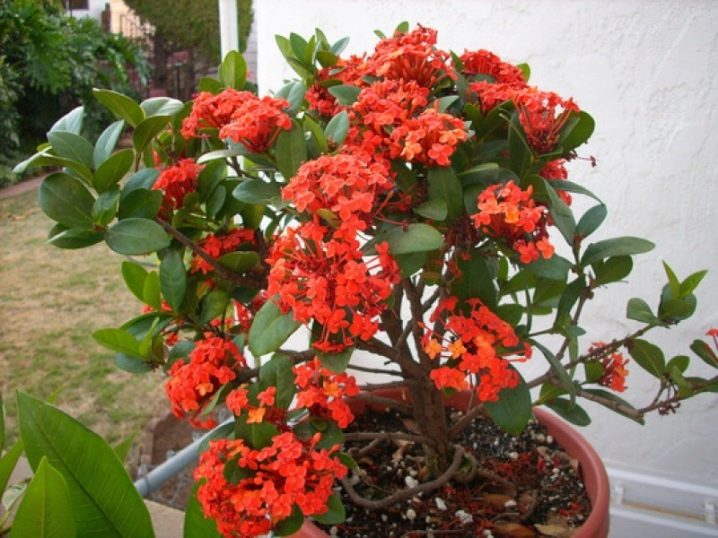
Views
Ixora has many varieties, each of which has its own characteristics and attracts the attention of flower growers with unusual details.
Karmazinovaya
Karmazinovaya Ixora is a fairly popular variety that is called J2 in the botanical classification. Among the characteristic features are long oval-shaped leaves. The average height of a house flower is 100 cm.
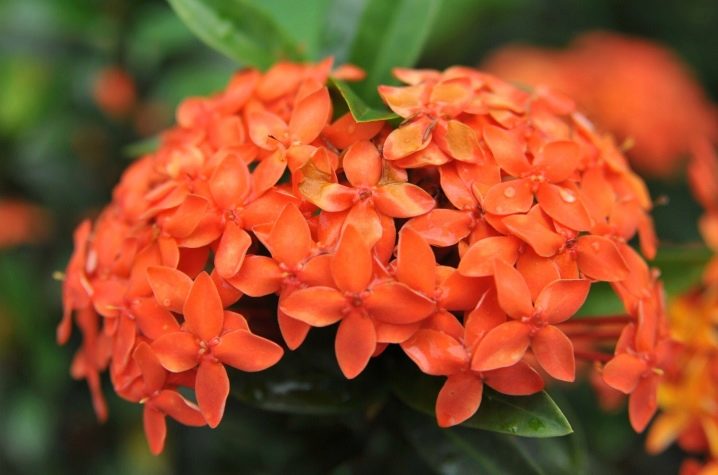
Javanese
Ixora Javanese - or I. javanica - is a variegated flower, the buds of which are painted in bright red. The peculiarity of the plant is in pointed petals. The homeland of the Javanese Ixora is the island of Java.
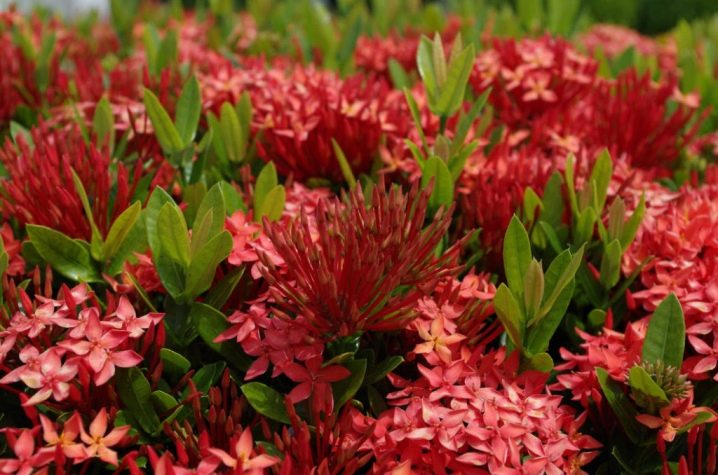
Bright red
The bright red Ixora is a unique cultivar whose flowers have a pleasant pink or salmon-orange hue. The rounded tip of the petals and long stems are the hallmarks of the culture from India.
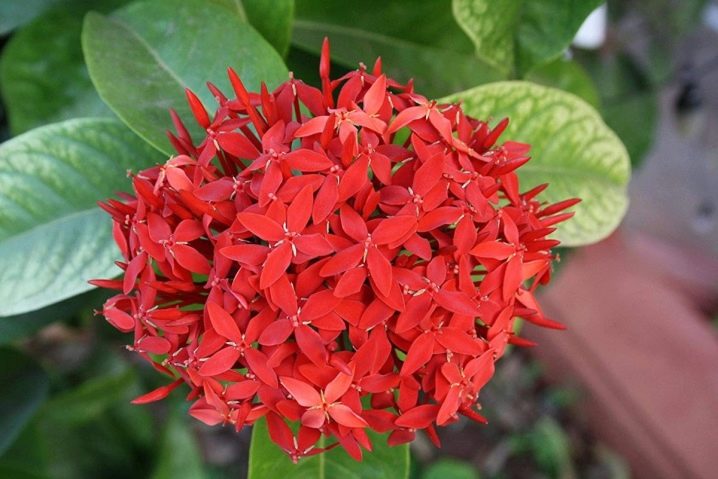
Chinese
The Chinese Ixora is distinguished by long stems that reach 100 cm in height. Dark green leafy plates with a pointed tip and pink, yellow or white flowers are the main characteristics of the variety.
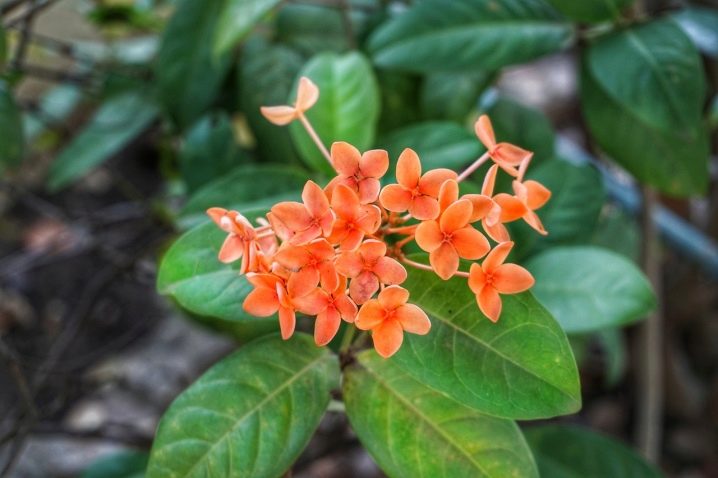
Griffith
It is a shrub that rises up to a meter in height and is distinguished by large elliptical leaves reaching a length of 30 cm.Griffith's Ixora buds are collected in an umbrella-shaped brush, have a pleasant orange tint, which gradually turns red.

Fragrant
A variety of white ixora, the peculiarity of which lies in the fragrant buds that form large inflorescences. Among the features are resistance to harsh growing conditions and strong stems.
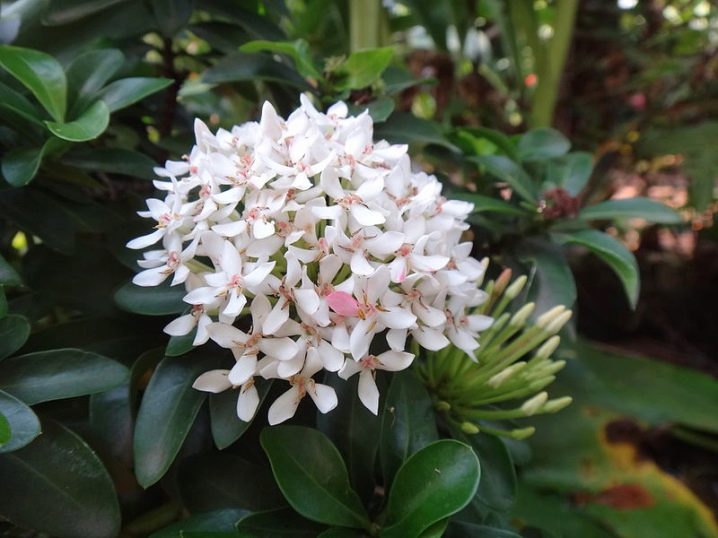
Finlayson
The homeland of the variety is Thailand and South China. The peculiarities of Ixora Finlayson are large leafy plates of rich green color and snow-white flowers with a pleasant strong aroma.
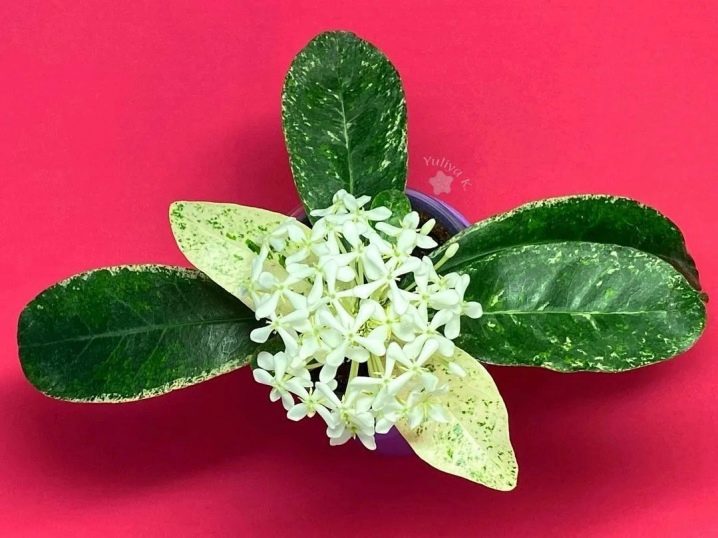
Wavy
It grows mainly in Bengal. The uniqueness of Ixora in leaves with a wavy edge, as well as in buds painted in coral red or snow-white shades. As the flowers develop, they form large apical inflorescences and give off a pleasant smell.
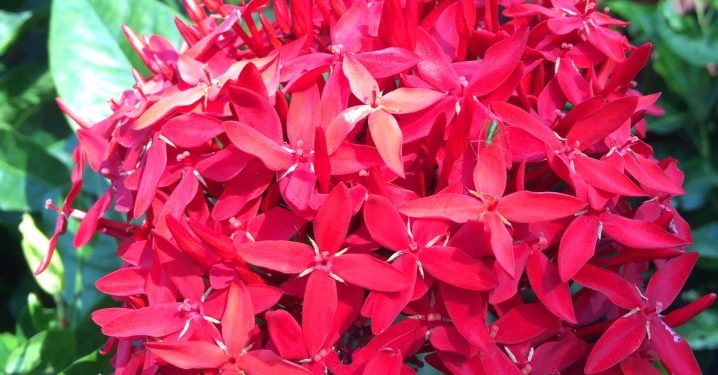
There are other varieties of Ixora, for example, variegated... The article lists only the most popular ones.
Landing
You can grow Ixora at home, if you take into account the basic recommendations for planting. First of all, you need to take care of choosing a place where the flower pot will stand. It is recommended to give preference to areas with good illumination, but without direct sunlight. The best solution would be window sills from the southwest or southeast.
It is not easy to grow an ixora, since the bush is quite capricious and quickly gets sick even with minimal deviations in temperature or humidity. Basically, flower growers for planting acquire a ready-made plant, which will remain to be carefully conveyed to the destination and left to take root.
However, some plant lovers prefer to grow a flower from cuttings on their own, as young bushes adapt faster in the house and even begin to bloom.
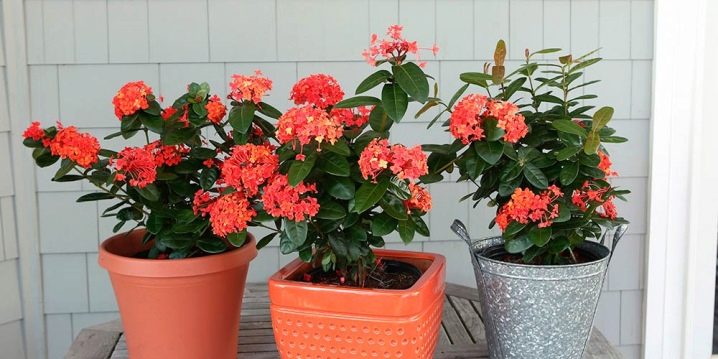
Care
When the plant is planted, it will be necessary to take care of the care of the crop. Basic moments.
-
Temperature... In summer, in the room where the flower stands, the temperature must be maintained at 22 ... 25 degrees Celsius, in winter the indicator can be reduced to 14 ... 16 degrees.
-
Humidity... The optimal indicator is at least 60%, since the plant loves a humid climate. In addition, flower growers advise to spray the leaves with soft and settled warm water, while observing so that drops do not fall on the petals. If it is not possible to regularly spray the plant, you can put a humidifier next to the pot.
-
Watering. It is important to ensure that the soil in the pot does not dry out. This is especially true during the abundant flowering of the bush. In autumn and winter, watering should be reduced to 1 time per week. Regardless of the season, you should additionally add a small amount of lemon juice to the water for irrigation, and also pre-settle the solution.
-
Top dressing... Basically, fertilizers are applied during the season from spring to autumn, when the plant is actively forming buds. Preference is given to liquid preparations, which do not contain lime. Fertilizers for orchids are great for ixora. Top dressing should be applied every 14 days.
-
Transfer... To make the "forest flame" feel comfortable at home, it is planted in a small flowerpot, due to the small volume of the root system. It is recommended to change the pot and soil every year, while the bush is actively growing and expanding. After the transplant time, it can be reduced to 1 time in 2-3 years. Soils with a neutral acidity index are used as a soil for transplanting, previously laying a drainage layer on the bottom of the pot to prevent moisture stagnation.
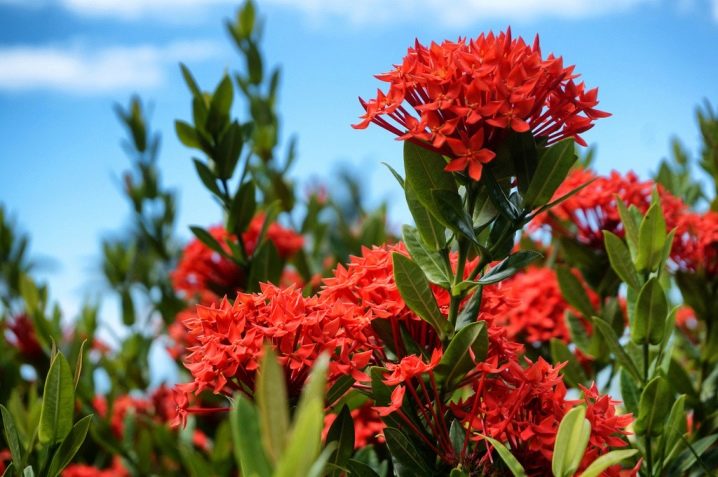
Timely caring for ixora will help the plant quickly take root and develop into a large bush, which will delight with variegated buds every season for 7 years.
Reproduction
There are two ways of breeding Ixora: cuttings and planting seeds. Each of the options is worth considering in more detail.
Cuttings
The most preferred breeding procedure, which does not require much time and effort.
-
First, small branches of Ixora are cut off, choosing elements on the tops of semi-lignified shoots. Work is carried out in the spring before the buds appear. The maximum length of the cutting should not exceed 8-10 cm.
-
Then carry out bottom ground heating, and setting the required room temperature so that the cuttings take root faster.
-
Cut branches are processed a stimulant for the growth of the root system. The drug "Kornevin" is perfect.
-
Next step - planting cuttings in small potspre-filled with a peat-sand mixture. You can also use peat, which contains perlite.
-
Afterwards, they set up a small greenhouse for Ixora, placing the pots under cut plastic bottles or covering the containers with polyethylene. At the same time, it is important not to forget about the need for regular airing of the samples for 4-6 weeks.
After rooting, the cuttings are planted in separate pots filled with soil more suitable for further growth of the bushes. Additionally, it is worth taking care of the pinching of the cuttings in order to accelerate the growth and development of the plant.
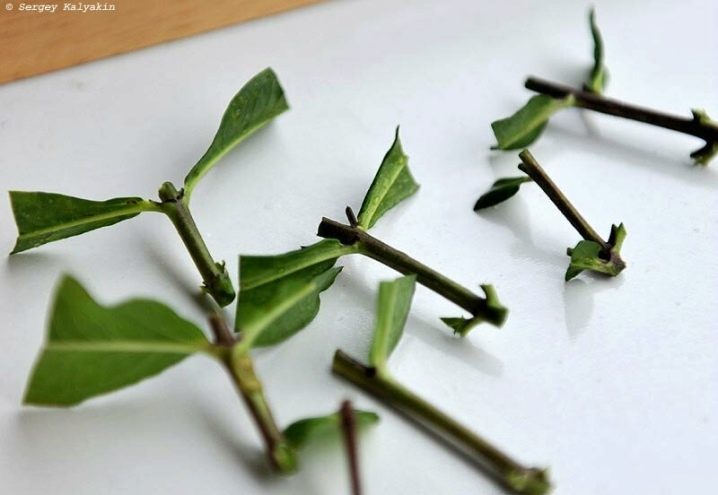
Planting seeds
This is also a fairly simple method, but it will take a long time for the seed to take root and germinate.
-
First, a container for sowing seeds is selected. Usually a bowl is used, where a small layer of fertile soil is poured.
-
Next, the prepared seeds are planted in the ground and sprayed, using growth stimulants and disinfectants.
-
The container is covered with polyethylene and placed in a warm place.out of direct sunlight.
The first sprouts will begin to erupt only after half a month. Upon reaching this stage, the shelter is removed, hardening the sprouts and thus helping them to adapt to room conditions. When the first pair of leaf plates appear on the seedlings, each sprout is transplanted into a separate pot.
And there are also ways to propagate Ixora by layering branches, or by using root shoots. But such options are rarely resorted to.
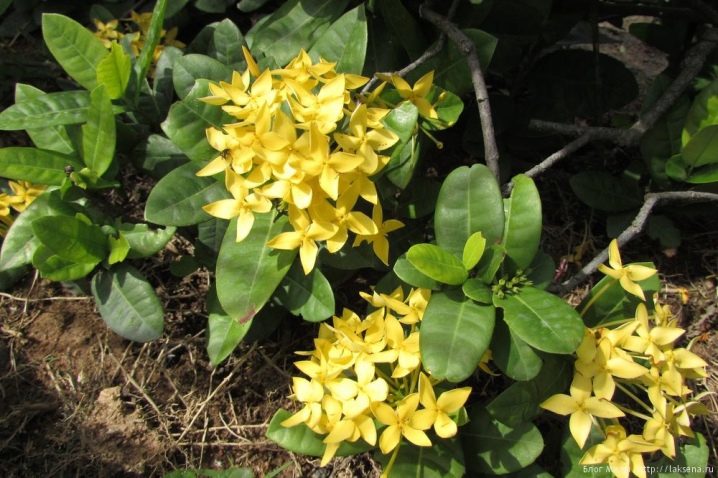
Diseases and pests
Ixora, which grows at home, has no pests and diseases. Although, if the recommendations for care are not followed, the plant may be attacked by ordinary indoor or greenhouse insects: thrips, whiteflies. To prevent the death of a flower, you should spray the bush with special preparations every day if an infection is detected. You can also use insecticidal soap to scare off potential pests.
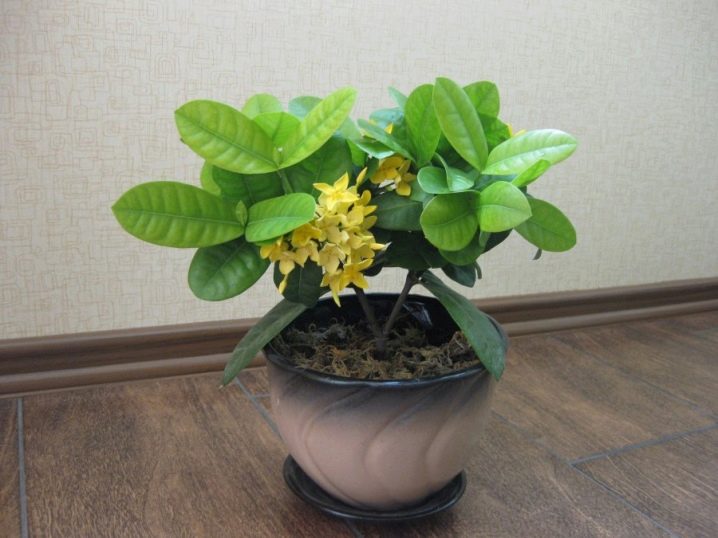







































































































The comment was sent successfully.